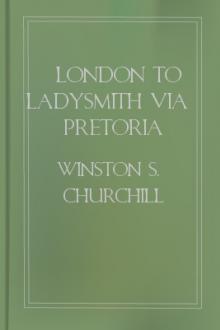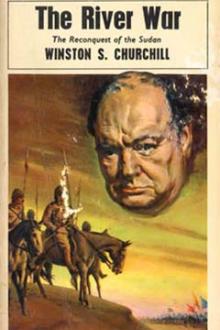London to Ladysmith via Pretoria - Winston Churchill (some good books to read TXT) 📗

- Author: Winston Churchill
- Performer: -
Book online «London to Ladysmith via Pretoria - Winston Churchill (some good books to read TXT) 📗». Author Winston Churchill
On the afternoon of February 4 the superior officers were made acquainted with the outlines of the plan of action to be followed. The reader will, perhaps, remember the description in a former letter of the Boer position before Potgieter's and Trichardt's Drift as a horizontal note of interrogation, of which Spion Kop formed the centre angle—/. The fighting of the previous week had been directed towards the straight line, and on the angle. The new operation was aimed at the curve. The general scheme was to seize the hills which formed the left of the enemy's position and roll him up from left to right. It was known that the Boers were massed mainly in their central camp behind Spion Kop, and that, as no demonstration was intended against the position in front of Trichardt's Drift, their whole force would be occupying the curve and guarding its right flank. The details of the plan were well conceived.
The battle would begin by a demonstration against the Brakfontein position, which the Boers had fortified by four tiers of trenches, with bombproof casemates, barbed wire entanglements, and a line of redoubts, so that it was obviously too strong to be carried frontally. This demonstration would be made by Wynne's Brigade (formerly Woodgate's), supported by six batteries of Artillery, the Howitzer Battery, and the two 4.7-inch naval guns. These troops crossed the river by the pontoon bridge at Potgieter's on the 3rd and 4th, relieving Lyttelton's Brigade which had been in occupation of the advanced position on the low kopjes.
A new pontoon bridge was thrown at the angle of the river a mile below Potgieter's, the purpose of which seemed to be to enable the frontal attack to be fully supported. While the Artillery preparation of the advance against Brakfontein and Wynne's advance were going on, Clery's Division (consisting of Hart's Brigade and Hildyard's) and Lyttelton's Brigade were to mass near the new pontoon bridge (No. 2), as if about to support the frontal movement. When the bombardment had been in progress for two hours these three brigades were to move, not towards the Brakfontein position, but eastwards to Munger's Drift, throw a pontoon bridge covered first by one battery of Field Artillery withdrawn from the demonstration, secondly by the fire of guns which had been dragged to the summit of Swartkop, and which formed a powerful battery of fourteen pieces, viz., six 12-pounder long range naval guns, two 15-pounder guns of the 64th Field Battery, six 9-pounder mountain guns, and lastly by the two 50-pounder siege guns. As soon as the bridge was complete Lyttelton's Brigade would cross, and, ignoring the fire from the Boer left, extended along the Doornkloof heights, attack the Vaal Krantz ridge, which formed the left of the horseshoe curve around the debouches of Potgieter's. This attack was to be covered on its right by the guns already specified on Swartkop and the 64th Field Battery, and prepared by the six artillery batteries employed in the demonstration, which were to withdraw one by one at intervals of ten minutes, cross No. 2 pontoon bridge, and take up new positions opposite to the Vaal Krantz ridge.
If and when Vaal Krantz was captured all six batteries were to move across No. 3 bridge and take up positions on the hill, whence they could prepare and support the further advance of Clery's Division, which, having crossed, was to move past Vaal Krantz, pivot to the left on it, and attack the Brakfontein position from its left flank. The 1st Cavalry Brigade under Burn-Murdoch (Royals, 13th and 14th Hussars, and A Battery R.H.A.) would also cross and run the gauntlet of Doornkloof and break out on to the plateau beyond Clery's Division. The 2nd Cavalry Brigade (South African Light Horse, Composite Regiment, Thorneycroft's, and Bethune's Mounted Infantry, and the Colt Battery) were to guard the right and rear of the attacking troops from any attack coming from Doornkloof. Wynne was to co-operate as opportunity offered. Talbot Coke was to remain in reserve. Such was the plan, and it seemed to all who heard it good and clear. It gave scope to the whole force, and seemed to offer all the conditions for a decisive trial of strength between the two armies.
On Sunday afternoon the Infantry Brigades began to move to their respective positions, and at daylight on the 5th the Cavalry Division broke its camp behind spearman's. At nine minutes past seven he bombardment of the Brakfontein position began, and by half-past seven all the Artillery except the Swartkop guns were firing in a leisurely fashion at the Boer redoubts and entrenchments. At the same time Wynne's Brigade moved forward in dispersed formation towards the enemy, and the Cavalry began to defile across the front and to mass near the three Infantry Brigades collected near No. 2 pontoon bridge. For some time the Boers made no reply, but at about ten o'clock their Vickers-Maxim opened on the batteries firing from the Potgieter's plain, and the fire gradually increased as other guns, some of great range, joined in, until the Artillery was sharply engaged in an unsatisfactory duel—fifty guns exposed in the open against six or seven guns concealed and impossible to find. The Boer shells struck all along the advanced batteries, bursting between the guns, throwing up huge fountains of dust and smoke, and covering the gunners at times completely from view. Shrapnel shells were also flung from both flanks and ripped the dusty plain with their scattering bullets. But the Artillery stood to their work like men, and though they apparently produced no impression on the Boer guns, did not suffer as severely as might have been expected, losing no more than fifteen officers and men altogether. At intervals of ten minutes the batteries withdrew in beautiful order and ceremony and defiled across the second pontoon bridge. Meanwhile Wynne's Brigade had advanced to within twelve hundred yards of the Brakfontein position and retired, drawing the enemy's heavy fire; the three brigades under Clery had moved to the right near Munger's Drift; the Cavalry were massed in the hollows at the foot of Swartkop; and the Engineers had constructed the third pontoon bridge, performing their business with excellent method and despatch under a sharp fire from Boer skirmishers and a Maxim.
The six batteries and the howitzers now took up positions opposite Vaal Krantz, and seventy guns began to shell this ridge in regular preparation and to reply to three Boer guns which had now opened from Doornkloof and our extreme right. A loud and crashing cannonade developed. At midday the Durham Light Infantry of Lyttelton's Brigade crossed the third pontoon bridge and advanced briskly along the opposite bank on the Vaal Krantz ridge. They were supported by the 3rd King's Royal Rifles, and behind these the other two battalions of the Brigade strengthened the attack. The troops moved across the open in fine style, paying no attention to the enemy's guns on Doornkloof, which burst their shrapnel at seven thousand yards (shrapnel at seven thousand yards!) with remarkable accuracy. In an hour the leading companies had reached the foot of the ridge, and the active riflemen could be seen clambering swiftly up. As the advance continued one of the Boer Vickers-Maxim guns which was posted in rear of Vaal Krantz found it wise to retire and galloped off unscathed through a tremendous fire from our artillery: a most wonderful escape.
The Durham Light Infantry carried the hill at the point of the bayonet, losing seven officers and sixty or seventy men, and capturing five Boer prisoners, besides ten horses and some wounded, Most of the enemy, however, had retired before the attack, unable to endure the appalling concentration of artillery which had prepared it. Among those who remained to fight to the last were five or six armed Kaffirs, one of whom shot an officer of the Durhams. To these no quarter was given. Their employment by the Dutch in this war shows that while they furiously complain of Khama's defence of his territory against their raiding parties on the ground that white men must be killed by white men, they have themselves no such scruples. There is no possible doubt about the facts set forth above, and the incident should be carefully noted by the public.
By nightfall the whole of General Lyttelton's Brigade had occupied Vaal Krantz, and were entrenching themselves. The losses in the day's fighting were not severe, and though no detailed statement has yet been compiled, I do not think they exceeded one hundred and fifty. Part of Sir Redvers Buller's plan had been successfully executed. The fact that the action had not been opened until 7 A.M. and had been conducted in a most leisurely manner left the programme only half completed. It remained to pass Clery's Division across the third bridge, to plant the batteries in their new position on Vaal Krantz, to set free the 1st Cavalry Brigade in the plain beyond, and to begin the main attack on Brakfontein. It remained and it still remains.
During the night of the 5th Lyttelton's Brigade made shelters and traverses of stones, and secured the possession of the hill; but it was now reported that field guns could not occupy the ridge because, first, it was too steep and rocky—though this condition does not apparently prevent the Boers dragging their heaviest guns to the tops of the highest hills—and, secondly, because the enemy's long-range rifle fire was too heavy. The hill, therefore, which had been successfully captured, proved of no value whatever. Beyond it was a second position which was of great strength, and which if it was ever to be taken must be taken by the Infantry without Artillery support. This was considered impossible or at any rate too costly and too dangerous to attempt.
During the next day the Boers continued to bombard the captured ridge, and also maintained a harassing long-range musketry fire. A great gun firing a hundred-pound 6-in. shell came into action from the top of Doornkloof, throwing its huge projectiles on Vaal Krantz and about the bivouacs generally; one of them exploded within a few yards of Sir Redvers Buller. Two Vickers-Maxims from either side of the Boer position fired at brief intervals, and other guns burst shrapnel effectively from very long range on the solitary brigade which held Vaal Krantz. To this bombardment the Field Artillery and the naval guns—seventy-two pieces in all, both big and little—made a noisy but futile response. The infantry of Lyttelton's Brigade, however, endured patiently throughout the day, in spite of the galling cross-fire and severe losses. At about four in the afternoon the Boers made a sudden attack on the hill, creeping to within short range, and then opened a quick fire. The Vickers-Maxim guns supported this vigorously. The pickets at the western end of the hill were driven back with loss, and for a few minutes it appeared that the hill would be retaken. But General Lyttelton ordered half a battalion of the Durham Light Infantry, supported by the King's Royal Rifles, to clear the hill, and these fine troops, led by Colonel Fitzgerald, rose up from their shelters and, giving three rousing cheers—the thin, distant sound of which came back to the anxious, watching army—swept the Boers back at the point of the bayonet. Colonel Fitzgerald was, however, severely wounded.
While these things were passing a new pontoon bridge was being constructed at a bend of the Tugela immediately under the Vaal Krantz ridge, and by five o'clock this was finished. Nothing else was done during the day, but at nightfall Lyttelton's Brigade





Comments (0)